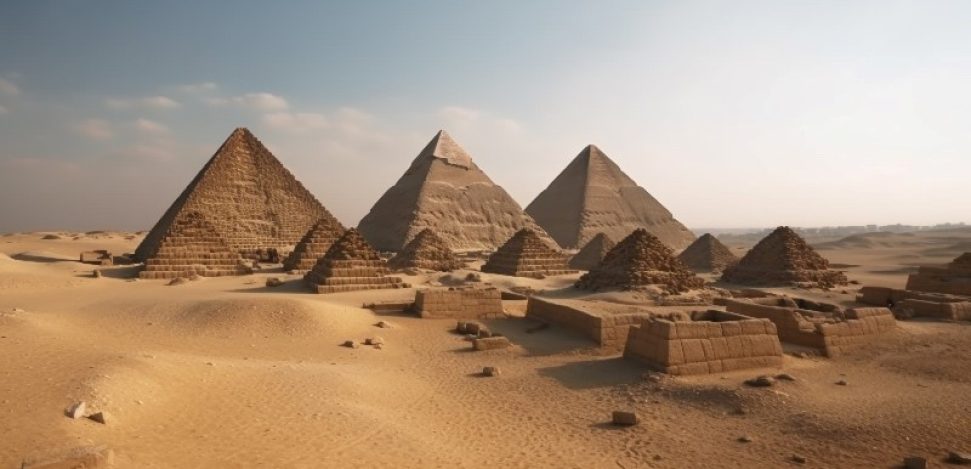The Egyptian pyramids offer a captivating window into ancient marvels, captivating tourists, students, and scholars alike. These structures ignite creativity and serve as a wellspring of inspiration in contemporary fields such as archaeology, architecture, and art. People worldwide are prompted to ponder questions about the pyramids, with some queries having found answers, while others remain unexplored. Delve below to uncover some lesser-known pyramid facts.
Surprising Facts About the Egyptian Pyramids
The Step Pyramid of Djoser is the oldest in Egypt
The Step Pyramid of Djoser, located in Saqqara, stands as the oldest Egyptian pyramid, marking the inaugural construction of such monumental structures by the Ancient Egyptians and representing the earliest large monument built with stone. Prior royal tombs had been crafted from mud brick. Djoser, the visionary behind this architectural feat, procured granite from the southern region of Aswan and limestone from the opposite bank of the Nile river, entrusting his vizier Imhotep with the oversight of construction.
The Aswan granite served the purpose of lining the King’s chamber within the pyramid. The construction of the Step Pyramid potentially held a symbolic significance, acting as a metaphorical staircase for Djoser’s transition from his earthly existence to the afterlife.
The initial true pyramid with smooth sides in Egypt was the Red Pyramid
In the ancient world, the purpose behind constructing the pyramids was to serve as protective structures for the sarcophagi of the pharaohs and to facilitate their journey toward the sun in the afterlife.
The Red Pyramid of Sneferu in Dahshur holds the distinction of being Ancient Egypt’s inaugural true pyramid, characterized by its smooth sides. Crafted to mimic the sun’s rays, it stands as the flattest pyramid in Ancient Egypt, featuring a gentle slope.
Unfortunately, this design flaw facilitated the ease with which robbers could traverse the structure and pilfer the white limestone covering its red core.
NORTHERN LIGHTS OF ALASKA: GAZE AN AURORA BOREA
The alignment of the Three Giza Pyramids is evident
Diagonally aligned, the southeastern corners of the Three Giza Pyramids, extending from the Great Pyramid of Khufu in the northeast of the necropolis to the Pyramid of Khafre and the smaller pyramid of Menkaure in the southeast, were intentionally arranged.
This deliberate orientation aimed to ensure that each of these corners was precisely directed towards the Temple of Ra at Heliopolis and harmonized with the constellation Orion.
The pharaohs of the 4th Dynasty, perceiving themselves as direct descendants of Ra, strategically angled their pyramids to seamlessly integrate their tombs into the daily life cycle of the sun, a central aspect of their religious beliefs.
Pyramids contained a hidden chamber where the soul of the deceased could find repose
Equally significant for the pharaohs as their pyramids was a concealed chamber known as the Serdab. Situated in proximity to the pharaoh’s mummy, the Serdab housed the Ka statue, which held the king’s life essence after death.
According to Ancient Egyptian beliefs, in the event of the pharaoh’s mummy being destroyed, his spirit could persist within the Ka statue. Due to the tangible risk of tombs being plundered and looted, the Serdab and its associated Ka statue held immense importance for the pharaoh in ensuring a serene and peaceful afterlife.
The Pyramid Texts: The Oldest Recognized Religious Texts Worldwide
Two centuries following the completion of the Pyramid of Menkaure, the Pyramid of King Unas emerged at Saqqara. Within the walls of its burial chamber, the “Pyramid Texts” were discovered—magical spells presented in hieroglyphic form designed to facilitate King Unas’ soul in departing from his body and embarking on its journey to the afterlife.
Acknowledged as the oldest recognized religious texts globally, the Pyramid Texts have played a pivotal role in enhancing our understanding of pharaohs, their roles, and the responsibilities they held in daily life. Notably, the Pyramid Texts from the Unas Pyramid offer the initial reference to Osiris, the god of the Underworld.
Climbing the Great Pyramids is strictly forbidden
Despite the steep sides deterring most climbers, both tourists and Cairo residents make attempts to reach the summit of the Great Pyramid of Khufu more frequently than one might expect.
However, those who venture to climb are typically apprehended on-site. Although Egyptian law prohibits climbing the pyramid, it is not deemed an illegal act. Instances of climbers being arrested or detained without charges are common.
In a notable case in 2016, a 16-year-old German tourist successfully ascended the pyramid in just over 8 minutes. More recently, a local individual threw rocks at authorities and caused damage to the wooden mast at the top, which is used to measure the height of the Great Pyramid.
BEST PLACES TO VISIT IN MOROCCO THAT YOU CAN’T-MISS!
The final Egyptian pyramid was constructed using mud bricks
The final Royal Pyramid in Egypt was constructed by King Ahmose I at Abydos, situated far south of the renowned pyramids at Giza, Saqqara, and Dahshur. Standing at approximately 50 meters in height, Ahmose’s pyramid formed part of a conventional, extensive mortuary complex and featured steep sides.
Unlike the colossal limestone blocks employed in the northern pyramids, Ahmose’s pyramid was primarily constructed from mud bricks. Unfortunately, the pyramid met its demise, collapsing into rubble over time due to the structural limitations of mud bricks, unable to endure like the more durable materials used in the pyramids further north.
The original color of the pyramids was white
The precision of Egyptian pyramid construction was showcased through casing stones, which were polished limestone caps displaying a remarkable level of accuracy. These white casing stones, covering the stones visible today, seamlessly interlocked, providing each pyramid with a strikingly smooth and flat appearance.
With a reflective quality like a mirror, the casing stones gleamed brightly, resembling polished jewels. Unfortunately, most of these casing stones have disappeared over time, often stolen, repurposed for the construction of other monuments, or damaged by seismic events, such as the significant earthquake that struck Cairo in 1308 CE.
A Sultan attempted to demolish the Pyramid of Menkaure
In the 12th century, Al-Aziz Uthman, the second Ayyubid Sultan of Egypt and son of Saladin undertook an unsuccessful endeavor to dismantle the Great Pyramid of Giza.
Al-Aziz assembled a substantial workforce to dismantle Menkaure’s temple, but the extensive expenses, time constraints, and formidable physical challenges posed by the pyramid stones and sand led to the abandonment of the project within a year. The Sultan’s efforts left only a vertical gouge on the north face of the smallest great pyramid as a result.
VISIT PETRA IN JORDAN: YOU’LL NOT BE DISAPPOINTED 🗺
Professional Teams Built the Pyramids
Professional construction teams, rather than slaves, were responsible for building the Great Pyramids, contrary to the assertions made by the renowned Greek historian Herodotus in his writings.
Entire towns were established adjacent to the pyramids, where families engaged in farming often contributed to the pharaoh’s remarkable construction endeavors while simultaneously tending to their crops.
2.3 million Limestone Blocks Were Used
For the construction of the Great Pyramid of Khufu, it is estimated that over 2.3 million limestone blocks were utilized. These blocks, some weighing up to 50 tons each, were crafted from granite and transported from Aswan in southern Egypt. The construction spanned over 23 years, and calculations suggest that work crews, at their peak, laid an average of 12 stones every hour during this period.
The project engaged over 100,000 workers throughout its lifespan, with a peak workforce of at least 1000 individuals. The original entrance to the Great Pyramid, situated 17 meters above the ground, is not in use by tourists. Instead, visitors enter through the “robber tunnel”, created in 820 CE when the Sultan of Cairo’s men breached the structure in search of treasure.
The Great Pyramid attracts approximately 14 million visitors annually, contributing nearly $9 billion to the economy. Remarkably, it is the sole surviving structure of the original Seven Wonders of the World.
As our understanding of the pyramids deepens, new questions continue to emerge. Despite numerous theories, ranging from the use of ramps and pulleys to water-assisted stone sleds, rolling wooden ramps, and extensive causeways, there is a lack of definitive evidence explaining the precise methods employed to lift and secure these massive stones.
Even though researchers comprehend the composition of the mortar that binds pyramid stones, they have been unable to replicate it. Despite employing heat imaging and satellite technology, scientists haven’t yet determined the contents or purpose of potential hidden chambers discovered. The enigma surrounding much of the Great Egyptian Pyramids persists, posing a challenge for both amateurs and professionals alike.





 smokingpaper
smokingpaper



























